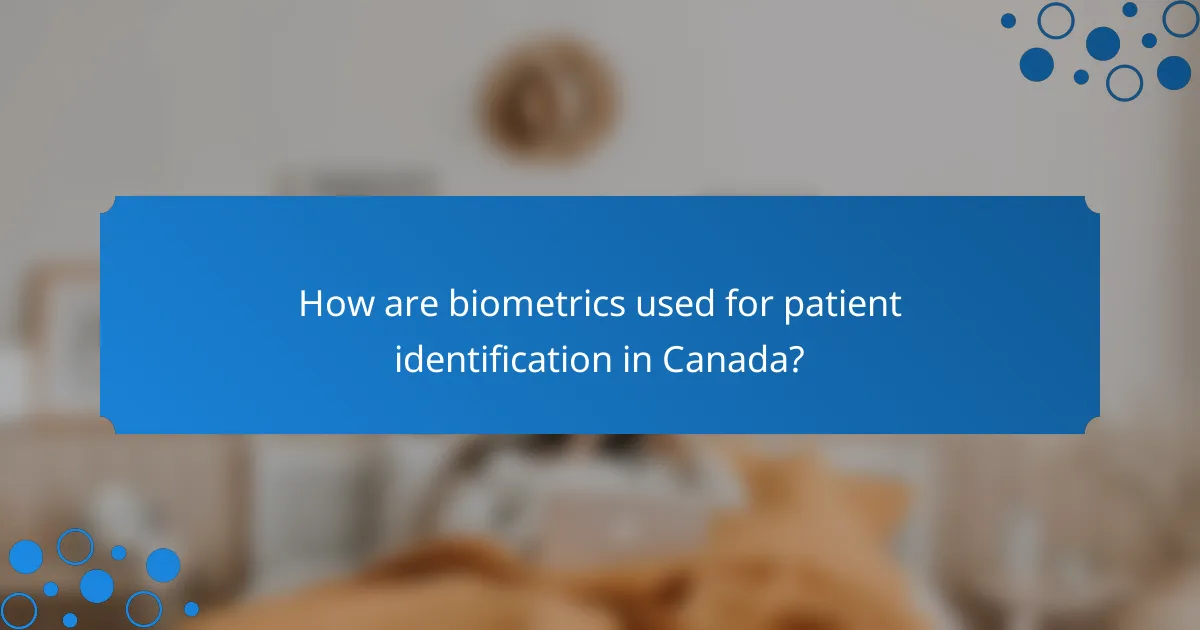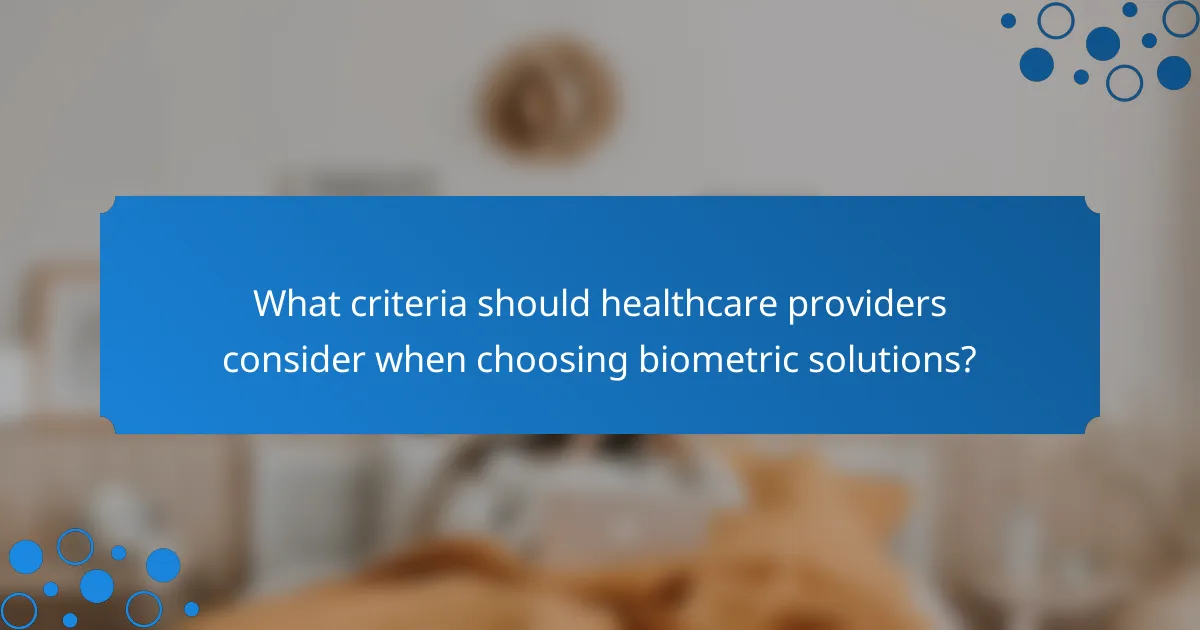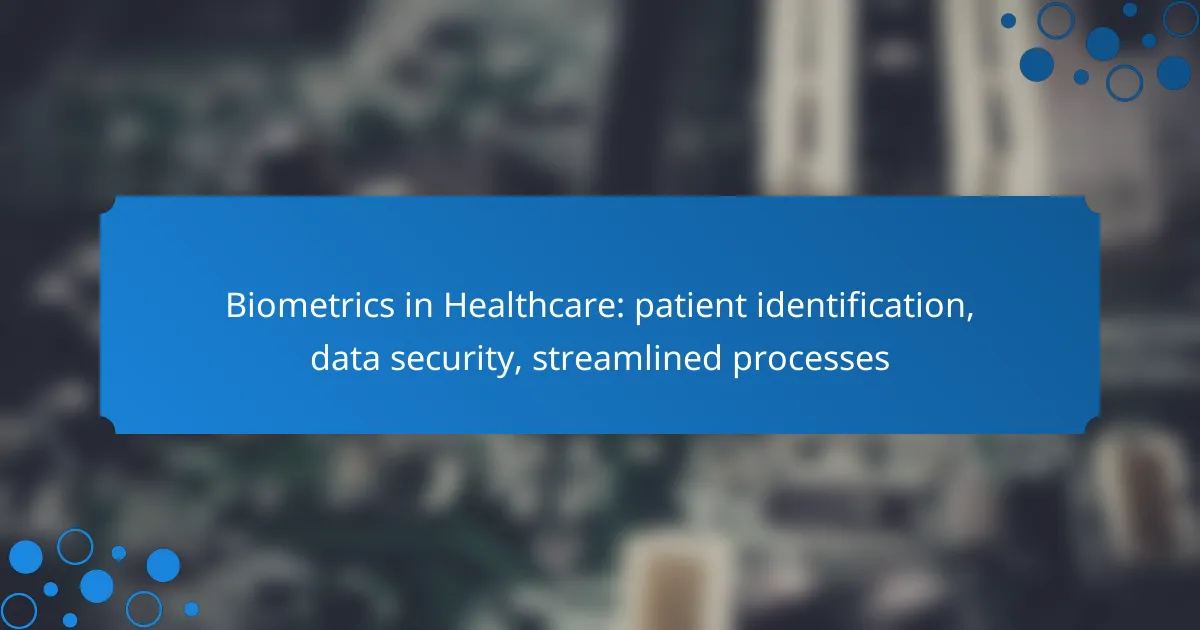Biometrics in healthcare revolutionizes patient identification by utilizing secure methods such as fingerprint and facial recognition, enhancing data security and efficiency. These technologies not only streamline processes but also contribute to improved patient outcomes by reducing wait times and ensuring accurate records.

How are biometrics used for patient identification in Canada?
In Canada, biometrics enhance patient identification by providing secure and efficient methods to verify identities. Common techniques include fingerprint recognition, facial recognition technology, and iris scanning, all aimed at improving data security and streamlining healthcare processes.
Fingerprint recognition
Fingerprint recognition is a widely adopted biometric method in Canadian healthcare for patient identification. This technology captures unique patterns of ridges and valleys on a person’s fingertip, allowing for quick and accurate verification.
Healthcare facilities often use fingerprint scanners at check-in points, which can reduce wait times and improve patient flow. However, it is essential to ensure that the fingerprint data is stored securely to comply with privacy regulations.
Facial recognition technology
Facial recognition technology uses algorithms to analyze facial features and match them against stored images. In Canada, this method is gaining traction for patient identification, particularly in hospitals and clinics.
This technology allows for contactless identification, which is beneficial in maintaining hygiene and efficiency in busy healthcare environments. However, it is crucial to address privacy concerns and ensure compliance with Canadian privacy laws when implementing such systems.
Iris scanning
Iris scanning is a highly accurate biometric method that captures the unique patterns in the colored part of the eye. In Canadian healthcare, iris scanning can be used for secure patient identification, particularly in high-security areas.
While iris scanning offers a high level of accuracy, it requires specialized equipment and may involve higher costs compared to other biometric methods. Healthcare providers should weigh the benefits against the investment needed for implementation.

What are the benefits of biometrics in healthcare?
Biometrics in healthcare offers significant advantages, including enhanced patient identification, improved data security, and streamlined processes. These benefits contribute to a more efficient and secure healthcare environment, ultimately leading to better patient outcomes.
Enhanced data security
Biometric systems, such as fingerprint or facial recognition, provide a robust method for securing patient data. By using unique biological traits, these systems reduce the risk of unauthorized access compared to traditional password-based methods.
Implementing biometrics can help healthcare organizations comply with regulations like HIPAA in the United States, which mandates strict data protection measures. This compliance not only protects patient information but also builds trust between patients and providers.
Improved patient experience
Biometrics streamline patient identification processes, reducing wait times and enhancing the overall experience. For instance, patients can quickly check in using their fingerprints, eliminating the need for lengthy paperwork.
Additionally, a seamless identification process minimizes the chances of errors in patient records, ensuring that individuals receive the correct treatments and medications. This efficiency can lead to higher patient satisfaction and loyalty.
Reduced administrative errors
By automating patient identification through biometrics, healthcare facilities can significantly reduce administrative errors. These errors often arise from misidentification or data entry mistakes, which can have serious consequences for patient care.
Biometric systems help ensure that the right patient is matched with their medical records, reducing the likelihood of mix-ups. This accuracy not only enhances patient safety but also streamlines administrative workflows, allowing staff to focus on care rather than paperwork.

How do biometrics streamline healthcare processes?
Biometrics streamline healthcare processes by automating patient identification and enhancing data security, which leads to more efficient workflows. By using unique biological traits, healthcare providers can reduce wait times and improve the accuracy of patient records.
Automated patient check-in
Automated patient check-in systems utilize biometric authentication, such as fingerprint or facial recognition, to verify patient identities quickly. This reduces the need for manual data entry, allowing patients to check in within seconds rather than minutes.
Healthcare facilities can implement kiosks equipped with biometric scanners, enabling patients to confirm their identity and complete necessary forms digitally. This not only speeds up the process but also minimizes errors associated with traditional check-in methods.
Secure access to medical records
Biometric systems provide secure access to medical records by ensuring that only authorized personnel can view sensitive information. For instance, healthcare workers can use fingerprint scans to log into electronic health record (EHR) systems, enhancing data protection.
Implementing biometric access can help healthcare organizations comply with regulations like HIPAA in the U.S., which mandates strict confidentiality of patient information. This added layer of security helps prevent unauthorized access and potential data breaches.
Real-time patient tracking
Real-time patient tracking through biometrics allows healthcare providers to monitor patient locations and status throughout their visit. By using wristbands with embedded biometric sensors, facilities can track patients from admission to discharge seamlessly.
This technology not only improves patient safety by ensuring that staff can quickly locate individuals in case of emergencies but also enhances operational efficiency by streamlining workflow management. For example, staff can receive alerts if a patient leaves a designated area, enabling timely interventions.

What are the challenges of implementing biometrics in healthcare?
Implementing biometrics in healthcare faces several challenges, including privacy concerns, integration with existing systems, and the cost of implementation. Addressing these issues is crucial for successful adoption and effective patient identification.
Privacy concerns
Privacy concerns are a significant barrier to implementing biometrics in healthcare. Patients may worry about how their biometric data, such as fingerprints or facial recognition, will be stored and used. Ensuring compliance with regulations like HIPAA in the United States is essential to protect patient information.
Healthcare providers must establish clear policies on data usage and obtain informed consent from patients. Transparency in how biometric data is collected, stored, and shared can help alleviate fears and build trust.
Integration with existing systems
Integrating biometric systems with existing healthcare infrastructure can be complex. Many healthcare facilities rely on legacy systems that may not support new biometric technologies. A thorough assessment of current systems is necessary to identify compatibility issues and potential upgrades.
Collaboration with IT professionals and biometric vendors is crucial for a seamless integration process. Planning for data migration and ensuring interoperability between systems can streamline patient identification and improve overall efficiency.
Cost of implementation
The cost of implementing biometric systems in healthcare can be substantial, including hardware, software, and training expenses. Initial investments may deter some facilities from adopting this technology. However, the long-term benefits, such as reduced fraud and improved patient safety, can justify the costs.
Healthcare organizations should consider a phased approach to implementation, starting with pilot programs to evaluate effectiveness and ROI. Budgeting for ongoing maintenance and updates is also essential to ensure the system remains effective over time.

What criteria should healthcare providers consider when choosing biometric solutions?
Healthcare providers should prioritize compliance with regulations, scalability of technology, and user-friendliness when selecting biometric solutions. These factors ensure that the systems are secure, adaptable to future needs, and accessible for both staff and patients.
Compliance with regulations
Compliance with regulations is crucial when implementing biometric solutions in healthcare. Providers must adhere to standards such as HIPAA in the United States, which mandates the protection of patient information. Ensuring that the chosen technology meets these legal requirements helps avoid potential fines and legal issues.
Additionally, healthcare organizations should verify that biometric systems comply with local data protection laws, which can vary significantly across regions. This includes understanding how biometric data is collected, stored, and shared.
Scalability of technology
Scalability refers to the ability of a biometric system to grow and adapt as the healthcare organization expands. Providers should consider whether the technology can accommodate an increasing number of users or additional functionalities without significant upgrades or costs. A scalable solution can save time and resources in the long run.
For example, a biometric system that initially supports fingerprint recognition might later integrate facial recognition or iris scanning as needs evolve. This flexibility is essential for healthcare providers looking to future-proof their investments.
User-friendliness
User-friendliness is vital for the successful adoption of biometric solutions in healthcare settings. Systems should be intuitive for both staff and patients to minimize training time and enhance the overall experience. A complicated interface can lead to frustration and decreased efficiency.
Providers should assess how easily users can enroll, authenticate, and access their information through the biometric system. Conducting user testing and gathering feedback from staff and patients can help identify any potential barriers to usability before full implementation.

How do biometric solutions compare in terms of accuracy?
Biometric solutions vary in accuracy based on the technology used and environmental factors. Fingerprint recognition typically boasts high accuracy rates, while facial recognition can be influenced by lighting and angles. Understanding these differences is crucial for selecting the right biometric system in healthcare settings.
Fingerprint vs. facial recognition
Fingerprint recognition is generally more accurate than facial recognition, with error rates often below 1%. This method relies on unique patterns in a person’s fingerprints, making it highly reliable in controlled environments. In contrast, facial recognition can have accuracy rates ranging from 85% to 95%, depending on factors like lighting and facial orientation.
Healthcare facilities may prefer fingerprint systems for patient identification due to their consistency. However, facial recognition offers advantages in speed and contactless operation, which can enhance patient experience during check-ins.
Iris scanning accuracy
Iris scanning is one of the most accurate biometric methods available, often achieving accuracy rates exceeding 99%. This technology analyzes the unique patterns in the colored part of the eye, making it highly reliable for patient identification. However, the cost and complexity of iris scanners can be a barrier for some healthcare providers.
For hospitals and clinics with high-security needs, iris scanning can be an excellent choice. It is particularly useful in environments where contactless identification is preferred, reducing the risk of cross-contamination.
Multi-modal biometric systems
Multi-modal biometric systems combine two or more biometric methods, such as fingerprints and facial recognition, to enhance accuracy and security. By leveraging multiple data points, these systems can significantly reduce the likelihood of false positives and negatives. This approach is particularly beneficial in healthcare, where accurate patient identification is critical.
Implementing multi-modal systems can improve user experience by providing flexibility in identification methods. However, they may require more complex integration and higher initial costs. Healthcare organizations should weigh these factors against the potential benefits of increased accuracy and security.
